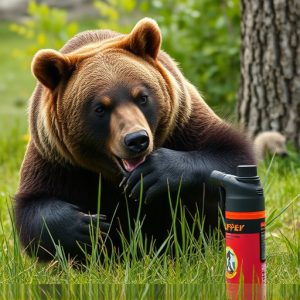Maximizing Wind Direction Bear Spray Safety for Hikers
Understanding bear behavior and leveraging wind direction are key for hikers' safety in bear-in…….
Understanding bear behavior and leveraging wind direction are key for hikers' safety in bear-inhabited areas. During spring and early summer, carrying bear spray is essential, with proper usage involving spraying against the wind at a 45-degree angle to maximize deterrence. Selecting approved bear repellent spray designed for close-range repellency, practicing application beforehand, and considering wind direction before hiking are vital for both hiker safety and wildlife preservation.
“Enhancing your hiking experience and ensuring bear spray safety is paramount, especially in areas where bears roam. This comprehensive guide explores the necessity of bear repellent spray, delving into the understanding of bear behavior, ideal wind direction for application, and the art of choosing the right product.
Learn about responsible hiking practices that boost your safety, offering insights on when and where to expect bear encounters. Master the techniques to maximize the effectiveness of bear spray in various conditions, especially considering crucial factors like wind direction.”
- Understanding Bear Behavior: When and Where to Expect Encounters
- The Role of Wind Direction in Bear Spray Effectiveness
- Choosing the Right Bear Spray: Safety Features and Application Techniques
- Responsible Hiking Practices for Enhanced Bear Spray Safety
Understanding Bear Behavior: When and Where to Expect Encounters
Understanding bear behavior is crucial for hikers, as it allows them to anticipate potential encounters and take necessary precautions. Bears are generally shy animals and prefer to avoid humans. However, their behavior can vary based on factors like season, food availability, and human activity. During late spring and early summer, bears emerge from their dens and seek food sources, which might bring them into areas frequented by hikers. This is when bear spray becomes an essential safety tool.
Knowing the wind direction is vital when carrying bear spray. It’s recommended to hike upwind, ensuring any potential bear has a chance to detect your presence and move away before you reach it. Always follow local guidelines and carry approved bear spray designed for effective repellency at close range. By understanding bear behavior, being mindful of their habitat, and using bear spray responsibly, hikers can minimize risks during outdoor adventures in areas known for bear activity.
The Role of Wind Direction in Bear Spray Effectiveness
The effectiveness of bear spray is heavily influenced by the wind direction during its use. When applying bear repellent spray, it’s crucial to consider the airflow patterns around you and the environment. Spraying into the wind can significantly reduce the reach and impact of the chemicals, making them less effective in creating a protective barrier. Conversely, spraying with the wind allows the noxious agents to travel further, increasing the chance of deterring an approaching bear effectively. Understanding and accounting for wind direction is a vital aspect of bear spray safety during hiking and outdoor activities in bear-inhabited areas.
For optimal results, users should aim to apply bear spray at a 45-degree angle to the wind. This technique balances the need to reach potential targets while ensuring that the spray doesn’t blow back onto the user or drift away without reaching the intended area. Being mindful of wind direction not only maximizes the spray’s effectiveness but also contributes to overall safety when encountering bears during outdoor adventures.
Choosing the Right Bear Spray: Safety Features and Application Techniques
When selecting bear repellent spray, understanding its safety features and application techniques is crucial for effective use during hikes in bear country. Look for products that are specifically designed for deterring bears, as not all sprays are created equal. Key safety features include a wide spray pattern, low odor or no scent, and a design that protects the user’s eyes from any backspray.
Proper application involves knowing the wind direction and aiming the spray towards the bear’s face and body. A successful spray should create a dense cloud of repellent to ensure maximum coverage. Practice using the spray in controlled environments before relying on it during hikes, as familiarity with its operation can make all the difference in a potentially dangerous encounter.
Responsible Hiking Practices for Enhanced Bear Spray Safety
When hiking in bear country, adopting responsible practices is paramount for both your safety and that of the wildlife. One of the most effective tools in your arsenal is bear repellent spray. Before setting out on a hike, take a moment to consider the wind direction; this simple step can significantly impact the effectiveness of your bear spray. Always carry it with you, ensuring it’s easily accessible, and familiarize yourself with its proper usage.
Understanding how to use bear spray in an emergency is crucial, especially when facing an aggressive encounter. Points to remember include aiming for the face and eyes of a bear, creating a barrier between you and the animal, and following up with multiple sprays if needed. Regularly reviewing these safety measures ensures that you’re prepared should an unexpected encounter occur during your hike.
When hiking in areas where bears are present, carrying bear repellent spray is an essential component of maintaining your safety. Understanding bear behavior, being aware of wind direction for optimal spray coverage, and choosing the right product with proper application techniques can significantly reduce risks during encounters. Additionally, adopting responsible hiking practices ensures not only your well-being but also the preservation of these magnificent creatures in their natural habitats. Prioritizing bear spray safety is a crucial step towards enjoying the outdoors responsibly, especially when navigating through regions known for their wild inhabitants.


